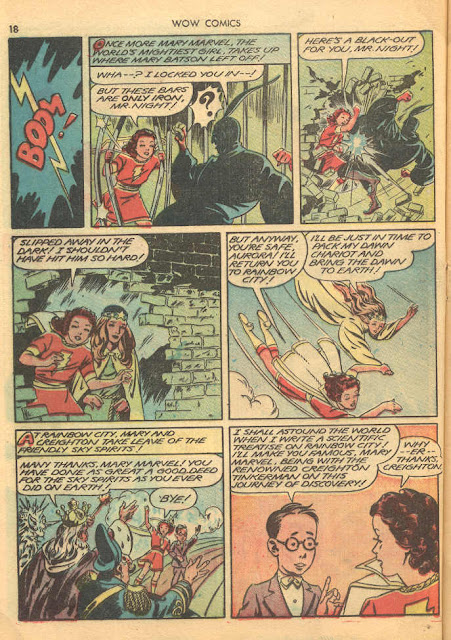This 1943 tale, written by Otto Binder and probably drawn by his brother Jack, is "metaphysical" in the sense of taking discriminate phenomena and attributing abstract aspects to them. I analyzed a story with a similar trope-- that of "light versus darkness"-- in THE PERIL OF PAINGLOSS. Here Mary Marvel encounters a war between "color" and "blackness," the latter to be understand in the visual sense, as the absence of all color perceptions.
In her civilian ID of Mary Batson, the heroine reads a newspaper story in which a reputable scientist claims that the legend of the "Pot of Gold at the Rainbow's End" is real. Mary, being patriotic, wonders if this treasure could be used for America's war effort. At the same time, a crook named Porky Snork talks his gang into seeking out the same golden horde. Meanwhile, Mary finds out that the person claiming to have seen the pot of gold is not reputable science-guy Tinkerman but his self-important son Creighton.
When Porky and his thugs show up, Mary changes into her heroic identity, but can't manage to stop the malcontents from stealing the balloon Creighton meant to use to track down the rainbow's end. Mary flies after the balloon, towing Creighton behind her, perhaps less for his guidance than for his potential for comedy relief. When both protagonists and antagonists arrive at rainbow's end, they learn that the rainbow actually creates the pot of gold, as all the colors of the spectrum "drip" off the rainbow and coalesce into the fabled treasure.
Mary contends with the petty thieves, and the balloon drifts to the top of the rainbow, where all see a colorful city dwelling. Mary rather rashly punctures the balloon, and the crooks fall from the basket. However, the greedy men are rescued by a "Batplane" piloted by Mister Night, a mysterious figure in black. Mary clouts the new villain, but he escapes with Porky's gang, so Mary and Creighton decide to investigate the city. It turns out to be inhabited by "sky spirits" whose purpose is to dispense color to the mortal world.
King Color informs Mary that Mister Night was exiled from Rainbow City, and that he's probably planning some fell scheme against his former brethren. Sure enough, Night has apparently been waiting around for some plug-uglies to fall into his lap, since his first gambit is to send the thugs after Jack Frost.
(Jack Frost, incidentally, comes into the matter because there was a tradition in which the frosty fellow was portrayed as being the entity who "painted" plants with autumnal colors.)
Mary thwarts the thugs but Mister Night rescues them, while revealing that his real purpose was to kidnap "Aurora, Spirit of Dawn." The dark villain's true plot is to eliminate all colors from the mortal world, so that he can become Earth's ruler. Mary flies to "Night Land" to rescue Aurora, without whom dawn can't transpire on Earth. However, for all her myriad powers, Mary can't see in absolute darkness. She changes to her human self so that the magic lightning will illuminate the landscape. The same light allows Night to see and capture the intruder. However, because the story's running out of space, the fiend doesn't take the time to either clobber or gag Mortal Mary. She easily "shazams" her way back to her super-powered ID and slugs Night, though he escapes into the darkness of his domain.
With Aurora returned to her celestial duties, all that's left is the wrapup, as Porky's gang once again tries to acquire the pot of gold (with the use of a toboggan, yet), only to be captured by Mary. She also returns Creighton Tinkerman to his home, though one can wonder how much approbation he received for the discovery of Rainbow City, whether Mary donated the pot of gold to the war effort or not. I haven't found evidence that Mister Night ever returned, though Binder helpfully equates the shadowy evildoer with real-life world-beaters like "Hitler and his henchmen."
The inventiveness of Otto Binder's story is underscored by the writer's clear avoidance of the standard association of "pots of gold" with "leprechauns." How this association came to pass has received some online speculation, and I rather like (without necessarily advocating) the idea that rainbows became associated with wealth because at times heavy rainfall might uncover buried gold. Of course that's probably too reductive by half, and the real correlation is probably all sorts of supernatural spirits have been tied to underground stores of wealth, whether of natural or man-made provenance. Binder makes a strong association between "wealth" and the pleasures humans feel at the variety of natural colors, and extrapolates those pleasures into a race of color-bestowing spirits. Of course, the title suggests that Binder was aware of the use of the phrase "Over the Rainbow" in a famous song for the 1939 WIZARD OF OZ. There aren't any strong similarities between this story and the OZ film, though of course the latter also foregrounds the experience of prismatic beauty. It's interesting, though, that he includes Jack Frost as one of these dispensers of color-beauty, because when Frost paints plants with autumnal hues, that presages the "temporary death" of such plants worldwide, when Winter, the time of darkness, holds sway. I suppose Binder could have had Mary capture Mister Night like she would any common troublemaker. But it's fitting that he did not do so, since the darkness symbolizing Death is inextricably intertwined with the forces that bring forth light and Life.











No comments:
Post a Comment